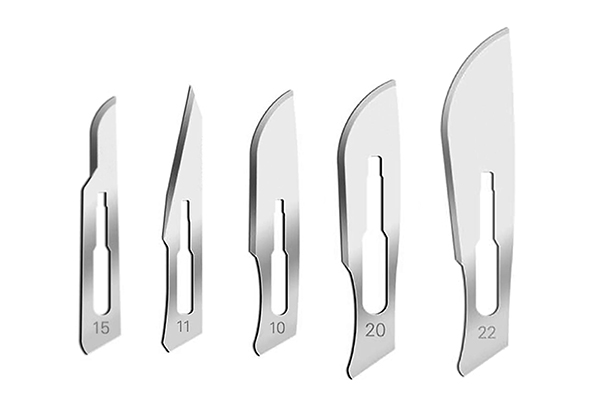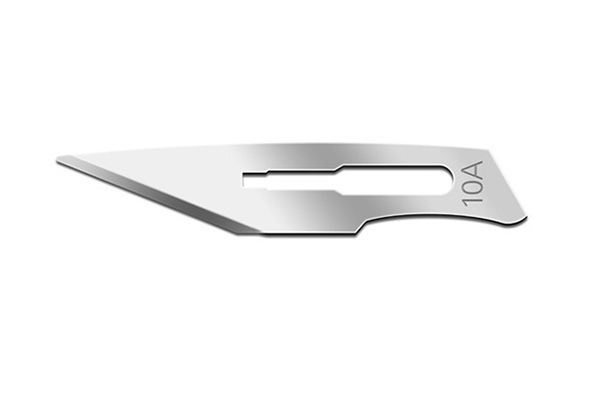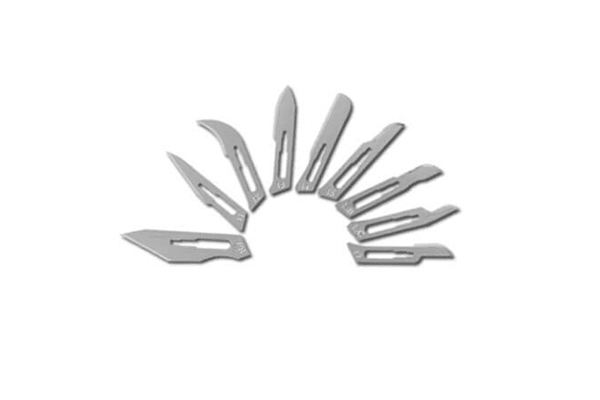In the high-stakes environment of the Eragiketa gela, every tool matters. But few are as critical as the bistal saldo. An extension of the surgeon’s hand, the eskuineko pala kirurgikoa can be the difference between a clean, quick-healing etiketa and one that causes unnecessary tissue trauma. For a hospital procurement manager like Mark Thompson, tasked with stocking a surgical center, the array of numbers, shapes, and materials can be daunting. What is the real difference between a #10 and a #15 xafla? When is karbono altzairua a better choice than Altzairu herdoilgaitza? As Allen, a manufacturer of disposable medical consumables in China, I’ve spent years overseeing the production of these essential tools. Hau Blade Tamaina Kirurgikoetarako Gida will demystify the world of the palo kirurgiko, helping you make informed decisions that bermatu your surgeons have the precision instruments they need to achieve the best patient outcomes.
What is a Surgical Blade and Why is Precision So Critical?
A palo kirurgiko, edo Bistalezko xafla, is a small, oso zorrotza cutting instrument used for surgery, anatomical dissection, and various other medical procedures. Unlike a standard knife, a palo kirurgiko is designed for a single purpose: to make clean, precise cuts with minimal damage to surrounding tissues. Hau precision is not just about aesthetics; it is fundamental to the healing process. A clean etiketa made with a sharp bistal saldo heals faster, has a lower risk of infection, and results in less scarring.
Hauek blades come in various shapes and sizes, each engineered for a specific surgical task. Whether a surgeon is making a large incision -an abdominal surgery or a delicate cut in plastic surgery, using the appropriate surgical blade is crucial. The goal is to cut tissue cleanly without crushing or tearing cells, which can trigger a greater inflammatory response and prolong recovery. This is why the quality, zorroztasun, and design of every palo kirurgiko are of the utmost importance.
Decoding the Numbers: What Do Surgical Blade Sizes Really Mean?
The numbering system for pala kirurgikoak can seem counterintuitive at first, but it provides a standardized way for surgeons to identify the exact Xafla tamaina eta forma they need. The system generally categorizes aza based on the handle they fit and their intended use.
Here’s a basic breakdown:
- Blades #10 through #19: Hauek aza fit a #3 Scalpel Handle. They are typically smaller and used for more delicate or specialized procedures.
- Blades #20 through #25: Hauek pala handiagoak fit a #4 Scalpel Handle and are maiz erabiltzen da for making larger incisions in general surgery or autopsy.
-A zenbaki de Bistalezko xafla refers to its specific size and shape. For example, a #10 xafla and a #15 xafla will both fit a #3 handle, but they have very different shapes and are used for different types of cuts. Understanding this system is the first step in choosing the right surgical blade.
An In-Depth Look at the Most Common Types of Surgical Blades
While dozens of Blade motak exist, a few key sizes are staples in virtually every Eragiketa gela. Knowing their characteristics is essential for any medical supply manager.
| Blade zenbakia | Deskribapen | Common Uses |
|---|---|---|
| #10 Blade | A Pala kurbatua with a large cutting edge. It is one of the most common blade shapes. | Used for making large incisions in skin and muscle, such as in general and orthopedic surgery. |
| #11 Blade | A triangular xafla with a sharp, pointed tip. Also known as a "stab" xafla. | Egiteko erabiltzen da precise, short incisions, such as draining an abscess or inserting a chest tube. |
| #15 Blade | A small Pala kurbatua with a smaller cutting edge, resembling a miniature #10 xafla. | Typically used for making small incisions, intricate cuts, or in pediatric or plastic surgery. |
| #20 Blade | A larger version of the #10 xafla, featuring a prominent curved cutting edge. | Used for larger incisions in procedures like thoracic or abdominal surgery. Fits a #4 handle. |
These four aza cover a vast range of Prozedura kirurgikoa needs, from broad, sweeping cuts to the most delicate punctures.

How Do You Choose the Right Blade for a Specific Surgical Incision?
Selecting the right surgical blade depends entirely on the task at hand. The choice is primarily dictated by the type of etiketa required and the tissue being cut. A surgeon considers several factors to Aukeratu eskubidea tool for maximum precision eta segurtasuna.
- For long, straight incisions: A large, Pala kurbatua bezala # 10 pala ala #20 blade is ideal. The bihurgune de xafla allows the surgeon to use the belly of the blade to create a smooth, continuous cut with a single motion. This is much more efficient and causes less Ehunen kalteak than making multiple small cuts.
- For short, precise cuts: When intricate work is needed, such as in ophthalmology or dermatology, a #15 blade is often the tool of choice. Its small size allows for greater control and maneuverability.
- For stab incisions: The sharply pointed #11 blade is specifically designed for this purpose. Its triangular shape is perfect for puncturing tissue to drain a fluid collection or to initiate an opening for inserting a tube or drain.
The surgeon’s training and experience are paramount, but having the right tools available is a prerequisite for success. This includes not just the xafla, but also related items like sterile sutures with needles to close the etiketa afterward.
Carbon Steel vs. Stainless Steel: Choosing the Right Blade Material
-A material of the blade is a critical factor that influences its performance, particularly its Zorrotza eta iraunkortasuna. The two most common materials for disposable pala kirurgikoak arrazoi dira karbono altzairua eta Altzairu herdoilgaitza. As a manufacturer, we produce both, as each has distinct advantages.
Karbono altzairuzko palak are renowned for their exceptional initial zorroztasun. The fine grain structure of karbono altzairua allows it to be honed to an incredibly fine edge, arguably sharper than Altzairu herdoilgaitza. Surgeons often prefer karbono altzairua for procedures where the utmost precision is required for the initial etiketa. Hala ere, karbono altzairua is more brittle and susceptible to rust and korgarri, so its packaging must be robust to protect it from humidity.
Stainless steel surgical blades, on the other hand, are highly resistant to korgarri. This makes them more durable and gives them a longer shelf life. While perhaps a fraction less sharp initially than karbono altzairua, kalitate handiko Altzairu herdoilgaitzezko palak maintain their edge well throughout a procedure. Their resistance to rust also means there is no risk of metal particles being left in the etiketa. The choice often comes down to surgical preference and the specific demands of the Prozedura kirurgikoa.

Why is the Scalpel Blade Handle Just as Important?
A Bistalezko xafla is useless without a handle to hold it. The Blade heldulekua, also known as a Bard-Parker handle, is a reusable instrument that the disposable xafla attaches to. Just as palak hainbat tamainatan sartzen dira, so do handles. The key is compatibility.
- #3 Handles: These are smaller and are designed to hold aza in the #10-#19 series. They are used for more delicate work.
- #4 Handles: These are larger and more robust, designed to hold the larger aza of the #20 series.
It is absolutely essential to match the blade size to the correct handle. Attempting to fit a #15 xafla onto a #4 handle will not work and is unsafe. When stocking an Eragiketa gela, it’s crucial to have a sufficient supply of both handle types to accommodate all the different Blade motak you provide. The handle’s weight, balance, and ergonomic grip also contribute to the surgeon’s control and reduce fatigue during long procedures.
How Does the Shape of the Blade Impact a Surgical Procedure?
-A pala forma is not arbitrary; each bihurgune and point is intentionally designed for a specific surgical function. The blade design dictates how it moves through tissue and the type of cut it produces. A straight blade, for example, is good for push cuts, while a Pala kurbatua is better for slicing.
-A bihurgune a-n # 10 pala allows for a long, sweeping etiketa where the pressure is distributed evenly along the cutting edge. This creates a cleaner cut than a straight edge, which would tend to dig in at the tip. The pointed tip of the #11 blade concentrates all the force at a single point, allowing for easy penetration with minimal effort. This variety in Xafla tamaina eta forma gives surgeons a versatile toolkit, allowing them to select the perfect instrument to bermatu the clean execution of kirurgiko guztiak step, from the initial etiketa to the final debridement.

From a Manufacturer’s View: How Do We Ensure the Sharpness of the Blade?
As a manufacturer, guaranteeing the quality and zorroztasun of our pala kirurgikoak is our highest priority. The process is a combination of using superior materials and employing advanced manufacturing techniques. It starts with sourcing high-grade karbono altzairua ala Altzairu herdoilgaitza from trusted suppliers.
The critical step is the grinding and honing process. We use automated, computer-controlled machines to create the cutting edge at a precise angle. This process is monitored at every stage to bermatu consistency. After grinding, each xafla undergoes a final finishing process to remove any microscopic burrs, resulting in a perfectly smooth, razor-sharp edge. Rigorous quality control checks, including microscopic inspection and sharpness testing, are performed on samples from every batch. This commitment to quality is how we bermatu that our blades remain sharp and reliable, which in turn enhances patient safety and supports positive surgical outcomes. These are the details that matter when choosing from various Hornidura medikoak.
Are There Other Materials and Types of Blades Used in Surgery?
Une karbono altzairua eta Altzairu herdoilgaitza dominate the market for disposable aza, specialty instrumentu kirurgikoak are sometimes made from other materials. These are typically more expensive and reserved for highly specialized fields.
- Zeramikazko palak: Blades made from ceramic are extremely hard and can hold an edge for a very long time. They are also non-magnetic, which is useful in procedures involving MRI.
- Diamond Blades: Used almost exclusively in ophthalmology, diamond aza are the sharpest cutting tools available, capable of making incredibly precise incisions in the delicate tissues of the eye.
- Reusable Blades: While most modern pala kirurgikoak are single-use disposables to prevent cross-contamination, some specialized, heavy-duty aza are designed to be Blades berrerabilgarriak after thorough sterilization.
For the vast majority of procedures, however, the choice between carbon eta Altzairu herdoilgaitzezko palak provides the necessary performance and is the most cost-effective solution for a busy hospital or surgical center.
Key Considerations When Choosing the Right Blade Supplier
For a procurement manager, choosing the right surgical blade extends to choosing the right supplier. Your decision impacts not just your budget but also the quality of care your facility provides.
- Kalitatea eta betetzea: Ensure the supplier adheres to international quality standards like ISO 13485 and has the appropriate regulatory approvals (e.g., CE marking, FDA clearance) for your market.
- Material Transparency: The supplier should be clear about the grade of karbono altzairua ala Altzairu herdoilgaitza used. This directly affects the blade’s Errendimendua.
- Koherentzia: -A zorroztasun eta kalitatearen kalitatea aza must be consistent from one batch to the next. Ask about their quality control processes.
- Paketearen osotasuna: Aza must be packaged securely in easy-to-open, sterile packets that protect them from damage and korgarri.
- Reliable Supply Chain: Your supplier must be able to deliver your orders on time to prevent shortages of these critical instrumentu kirurgikoak, like blades or Xurgatzeko hodiak.
Partnering with an experienced manufacturer who understands these requirements is key to keeping your Eragiketa gela well-stocked with reliable, high-performance pala kirurgikoak.
Takeaways gakoak
- The Number Matters: -A zenbaki a-n palo kirurgiko indicates its specific size and shape. Aza #10-#19 fit a #3 handle, while #20-#25 fit a #4 handle.
- Match the Blade to the Incision: Use large, curved blades (#10, #20) for long incisions and small, specialized aza (#11, #15) for precise or stab incisions.
- Material Choice is Key: Karbono altzairuzko palak offer superior initial zorroztasun, bitartean Altzairu herdoilgaitzezko palak provide excellent durability and korgarri resistance.
- Precision Prevents Trauma: Using the correct blade results in a cleaner cut, which leads to faster healing, less scarring, and a lower risk of infection.
- Quality is Non-Negotiable: -A zorroztasun, consistency, and sterility of a palo kirurgiko are critical for patient safety.
- Choose Your Supplier Wisely: Partner with a manufacturer who can provide high-quality, compliant pala kirurgikoak and demonstrate a reliable and transparent supply chain.
Post time: Oct-29-2025





